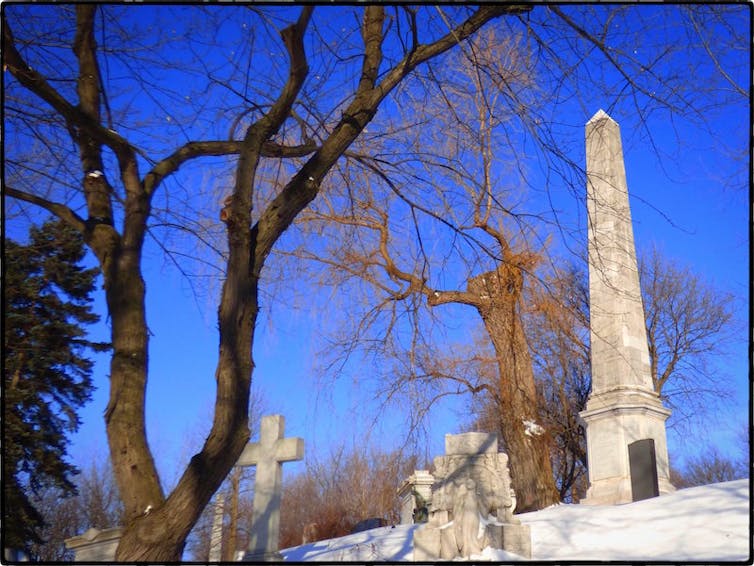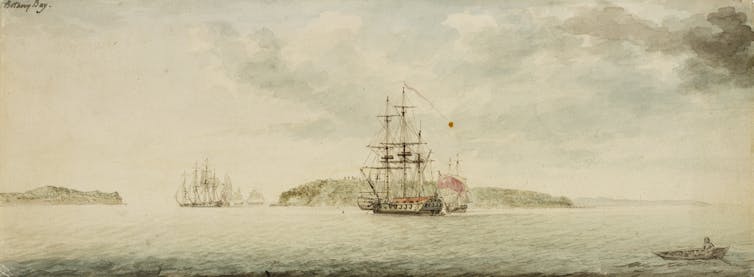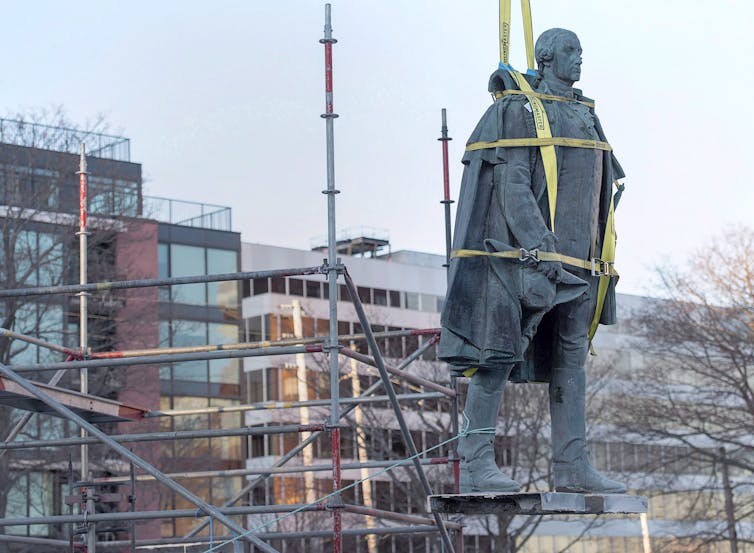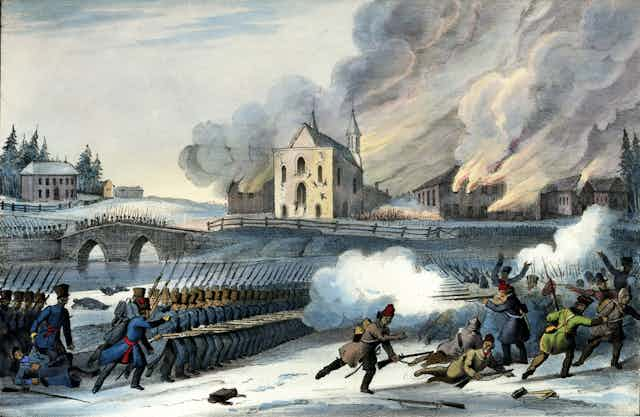The 15-metre high obelisk sits inconspicuously among the headstones and funerary sculptures of Montréal’s Notre Dame des Neiges, the largest cemetery in Canada. A passerby unaware of its significance might assume it was the gravestone of a prosperous though not ostentatious family.
But it isn’t a tomb. Nobody is buried underneath, and when it was erected in 1858, many of the people whose names are inscribed on the marble panels were still alive.
“Le Monument aux Patriotes” commemorates the 29 Francophone men who were executed by the British colonial government during the rebellions of 1837-1838, and their 58 compatriots who were transported to Botany Bay, Australia.
The inscription refers to “victimes politiques.” Terms like rebellion or insurrection, which are more accurate and what the monument actually commemorates, are deliberately avoided.
On Nov. 4, 1838, 75 French patriots went to the Iroquois village at Kahnawake, across the river from Montréal and opposite present day Lachine, to buy arms and allegiances against the British Government. How circumstances unfolded that night have been disputed ever since, but the result was that the patriots were captured by British soldiers.
At the same time, more than 500 French patriots surrounded the settlement at Beauharnois, about 16 kilometres to the south west of Kahnawake. On Nov. 10, the British soldiers responded with force, attacking the settlement and capturing more than 100 French patriots.
One hundred and eighty years later, at a moment when the re-evaluation of monuments to controversial figures is taking place around the world — from James Cook in Australia to Cecil Rhodes at Oxford and Edward Cornwallis in Halifax, N.S. — “Le Monument aux Patriotes” raises a set of related but different issues as to how past actions are commemorated.
Why is it placed where it is, hidden among gravestones, and not in a more typical site for a political monument? What does its placement say about the role the rebellions have in Canada’s history? What does the hidden nature of the obelisk say about the forgotten links between Québec and Australia, and more importantly, about the ways the past —and whose past — is commemorated in Canada?
The Rebellions of 1837-1838
The Canadian rebellions of 1837 and 1838, commemorated on the obelisk, are seen by contemporary historians as echoes of the Atlantic revolutions of the late 18th century like the American War of Independence and the French Revolution (1789-1799) in so far as broader political representation and economic reforms were at their heart.
For example, William Lyon MacKenzie, who established a brief Republic of Canada during the Patriots’ War of 1838, supported French-speaking agitators only when it was opportune, even though they held a common grievance against the British government.
On the Francophone side, the rebellions are part of a long history of tensions that can be traced from the Battle of the Plains of Abraham in 1759 to the separatist referenda of 1980 and 1995.

More than a just a commemoration of the uprisings, the monument acknowledges that history of Anglo-French relations, with all their antipathies and other bitter undercurrents.
Which is why its position in the cemetery is so odd. Because of its position, camouflaged by the tombstones it sits among, it looks like an attempt to forget.
Exiled to Botany Bay, Australia
Before the hearings of the prisoners captured at Kahnawake and Beauharnois began, the colonial administrator, John Colborne, altered the status of their trials from civilian to court martials, guaranteeing they’d be found guilty for insurrection against the military government rather than lesser crimes.
While some prisoners would be executed, Colborne also decided that 58 would be transported to the penal settlement at Botany Bay in New South Wales, Australia.
This was not an act of mercy.
The Botany Bay colony had a horrific reputation, as one of the prisoners from Québec, François-Maurice Lepailleur, would corroborate in his journal.
The analysis published by Lloyd Robson in 1965, in The Convict Settlers of Australia, explains that most convicts came from cities and were repeat offenders. The typical convict was male, in his mid-20s, unmarried and a labourer. Relatively few were political agitators.
In contrast, the prisoners transported from Québec were on average older. A few were farmers but some, including Lepailleur, had families and respectable jobs (he was a bailiff).

In an overwhelmingly Protestant British colony, the French Catholics received particular care from the Catholic priest John Brady, who arranged for the prisoners to receive communion and to hear their confessions.
They were sent to Longbottom, a cove on the Parramatta River. They would live in relative isolation from other convicts while they broke stone and made bricks for the ongoing construction of parts of present-day Parramatta Road in Sydney.
Although Lepailleur and the other French prisoners called themselves patriotes, the term most commonly used for them was exiles. After serving their seven-year sentences, all but one (Joseph Marceau, whom a street is named after) intended to return to Québec, and money was raised to assist those who could not afford the passage; something almost unthinkable for typical convicts.
All this leads to the feeling that there was embarrassment they had been sent to Botany Bay in the first place, something echoed with the monument’s hidden placement at the Montréal cemetery.
Monuments influence opinions of history
Memorials are never mute commemorations. They are intended to influence the way people view a site and history, and when all other physical evidence has disappeared, they can still influence opinion.

Monuments are typically erected to people or events. When they honour people, location can be independent, so the Maisonneuve Monument in Place d’Armes in central Montreal includes statues of the founder of the city, Paul Chomedey de Maisonneuve, and three settlers: Jeanne Mance, Charles Le Moyne and Lambert Closse, as well as an unnamed Iroquois male.
We don’t assume its position indicates a moment when the five people came together at that spot.
Three kilometres away, by the Victoria Bridge, the Black Rock Monument commemorates 6,000 Irish immigrants who died during an 1847 typhus epidemic.
That monument is close to where the mass grave of the victims was discovered by workers in the 1850s. Because it memorializes a tragedy, an event that occurred at that site, it could not have been placed anywhere else.
Which brings us back to the monument at Notre Dame des Neiges. The events it honours deserve commemoration. The men acknowledged belong to a fractious history in a province that has twice tried to separate from Canada in recent decades.
Why is the monument in the cemetery, and not at Kahnawake or Beauharnois, where the arrests took place? Or for that matter, why not on the grounds of the former Pied-du-Courant prison, near the Jacques Cartier Bridge, where the rebels were incarcerated? A monument to the 12 patriotes who were hanged in 1838 stands there although there is no mention of the exiles.
In an unpublished Masters thesis from 2004, historian Rosemary O’Flaherty observed that the positioning of the monument in the cemetery was the result of another conflict in the 1850s between the Institut Canadien, a group of liberal intellectuals, and Montréal’s powerful Catholic hierarchy.
The Institut envisioned a grand memorial to the patriots. Wishing to avoid confrontation with the government, the Church would have preferred no monument at all, but insisted upon the final location.
The result is a memorial that comes as close as one can to figuratively burying history.

